Best Board Games for 5 Year Olds
They’re not quite per-schooling toddlers anymore and still not kids ready to tackle the slightly more complex board games. We take a look in this roundup at the best board games for 5 year olds worth checking out that are just about right for the 5+ children!
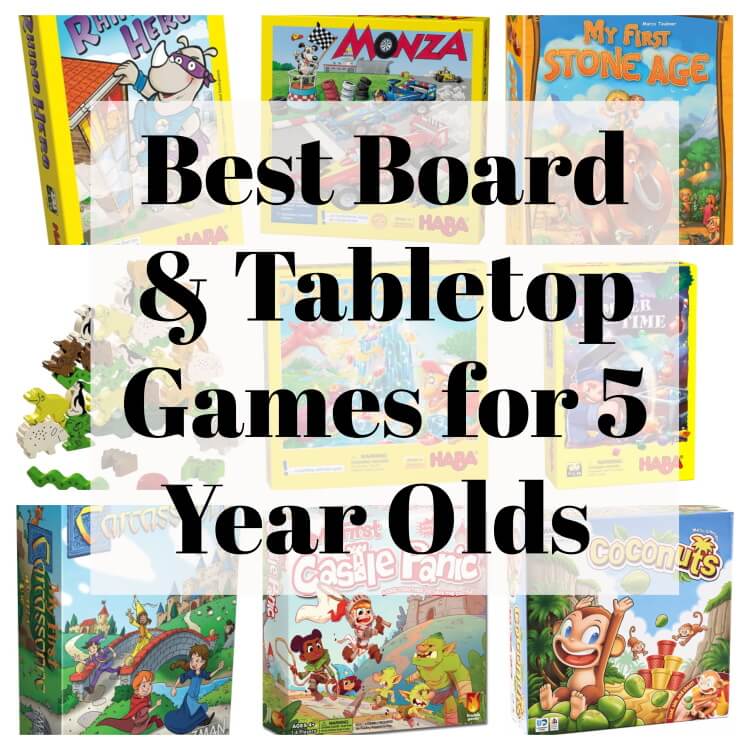
When it comes to board games to play with 5-year-olds, the common titles that many people think of are Candyland and Chutes & Ladders – in other words, games that require no decisions and ones where players simply flip a card or flick a spinner and do what it says.
Luckily, there are many modern board games for ages 5+ that are both mentally stimulating and can provide fun for adults to join in. If you’re looking for a fun gaming activity for your child, here are 12 games you should check out!
1. Carcassonne Junior (My First Carcassonne) – Best Tile-Placement Game
Carcassonne is a classic Spiel des Jahres family board game published in 2000 where players take turns placing tiles to build cities, roads, monasteries, and farms. While the game is fairly light-weight and easy to teach to a young audience, there are still aspects of the game that might be challenging for children as young as five to grasp, such as “claiming” a structure and matching terrain when placing a tile.
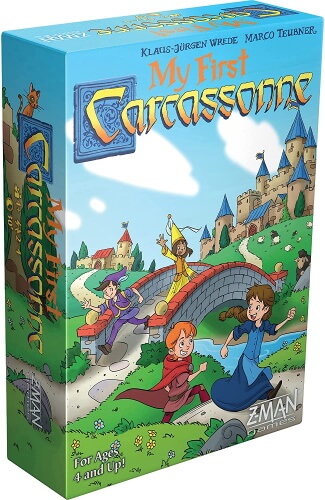
My First Carcassonne at a Glance
| Game Type Medieval Theme, Enclosure, Modular Board, Tile Placement | Play Time 10 - 20 mins | Skill/Complexity (1 - 5) Light |
| Age 4+ | Publisher(s) Z-Man Games and others | Published 2009 |
| Categories Family / Kids | Players 2 - 4 | Cost $34.95 approx. |
| Our Rating 7.7/10 |
Carcassonne Junior bridges that age gap by streamlining the rules of Carcassonne for young children. The game comes with large tiles and meeple, and much like the standard version of Carcassonne, players will take turns placing tiles onto the table. However, players don’t have to worry about matching terrain because every tile connects to a road on each side of the tile.
The goal of Carcassonne Junior is very simple: be the first player to place all your meeple onto the tiles on the table. Players take turns placing tiles, and once a road has been completed, players look for characters on that road. For each character who matches their player color, players place a meeple onto the road even if they weren’t the player who completed it.
The goal of Carcassonne Junior is very simple: be the first player to place all your meeple onto the tiles on the table. Players take turns placing tiles……….
That’s it! There’s no trying to complete cities, fields, or monasteries in Carcassonne Junior; it’s a very simple game that very young children can understand. It’s a great way to introduce some of the core concepts of Carcassonne that will make the standard version easy to teach when they eventually outgrow this version.
2. My First Castle Panic – Best Cooperative Game
Sometimes it can be much easier to teach children games when everyone is working together cooperatively to achieve a common goal. Castle Panic is a popular castle-defense family cooperative game, and My First Castle Panic is a very simplified version geared toward children 4 and up that is very easy to teach and for young children to grasp.
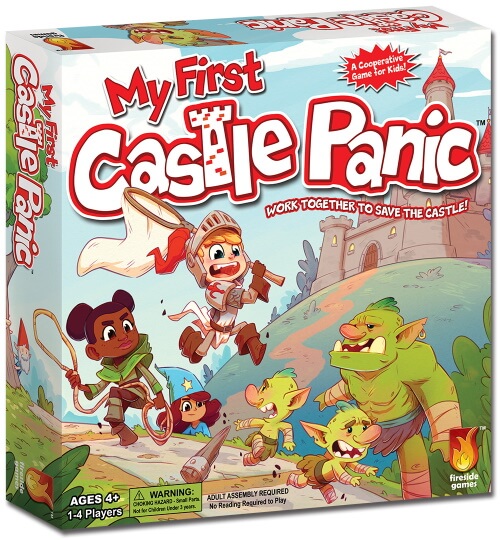
My First Castle Panic at a Glance
| Game Type Fantasy Theme, Cooperative Game, Hand Management, Matching, Solo / Solitaire Game | Play Time 20 mins | Skill/Complexity (1 - 5) Light |
| Age 4+ | Publisher(s) Fireside Games | Published 2019 |
| Categories Family / Kids | Players 1- 4 | Cost $19.95 approx. |
| Our Rating 8/10 |
In My First Castle Panic, players work together to save their castle from invading monsters that travel down a road toward their castle gates. After each player’s turn, all of the monsters on the board will move forward one space, and then a new monster will be revealed. Some monsters will trigger special events, such as making all of the monsters move forward an additional space. If any monster ever reaches the castle wall, the wall gets knocked down. Then, if any monster reaches the castle, the players lose the game.
In My First Castle Panic, players work together to save their castle from invading monsters that travel down a road toward their castle gates.
On a player’s turn they will draw a new card, and then they can choose a monster to get rid of by matching a card from their hand with the shape/color associated with a monster space on the board. Some cards let players get rid of any monster of a particular color/shape, or to rebuild the castle wall. A player can also ask another player for help if they wish, and players can share cards.
When a player gets rid of a monster, they can throw the monster into the “dungeon” (the box). If players manage to get rid of all the monsters, they win!
My First Castle Panic does a great job at teaching elements of cooperative board games, like helping other players by sharing cards, working toward a common goal, and trying to “outsmart” the game before it’s too late. The production value of the game is very high and at an affordable cost – children will love the castle and wall pieces, and throwing the monsters into the dungeon built within the game box.
3. Monza – Best Racing Game
If you’re looking for good games for children, Haba is a company that specializes in this category. You can’t go wrong by blind-picking a game from this company. It’s no surprise that multiple Haba games make this list! One game from Haba that has been around for quite some time (20 years in fact!) that continues to be a family favorite is Monza, a dice-rolling racing game.
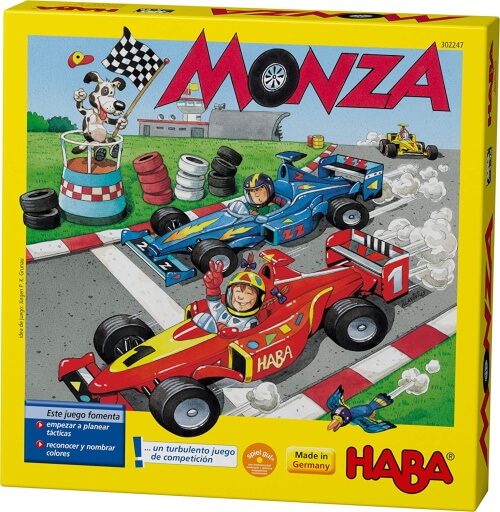
Monza at a Glance
| Game Type Racing Theme, Dice Rolling, Race, Track Movement | Play Time 10 mins | Skill/Complexity (1 - 5) Light |
| Age 5+ | Publisher(s) HABA | Published 2000 |
| Categories Family / Kids | Players 2- 6 (Ideal 4) | Cost $24.95 approx. |
| Our Rating 7.7/10 |
In Monza, players race around a racetrack by rolling 6 dice, and then using those dice to advance forward onto different colored spaces. Players can move through occupied spaces, but they cannot end their turn on one. Also, players cannot move onto grey spaces, adding a little bit of challenge when trying to decide which space to advance onto at various points in the race.
In Monza, players race around a racetrack by rolling 6 dice, and then using those dice to advance forward onto different colored spaces. Players can move through occupied spaces, but they cannot end their turn on one.
Monza is a great alternative to a game like Candy Land or Chutes and Ladders where a player’s victory is exclusively determined exclusively by luck and players have no decisions in the game. In Monza, players get to decide, out of the dice they rolled, how they would like to advance on the racetrack. Granted, sometimes there is only one (or no) choice to make depending on how the dice are rolled, but there are many points in the game where players must look at their dice and decide how they are going to maximize those dice to move as far forward on the game board as possible.
4. Rhino Hero – Best Alternative to Uno
Uno is the classic family card game where players try to be the first to get rid of cards from their hand by using card abilities to make other players draw cards, skip a turn, or reverse turn order. Rhino Hero, another game by Haba, is a game that builds upon this concept in a very fun way – players use cards in their hand to build a house of cards on the game table.
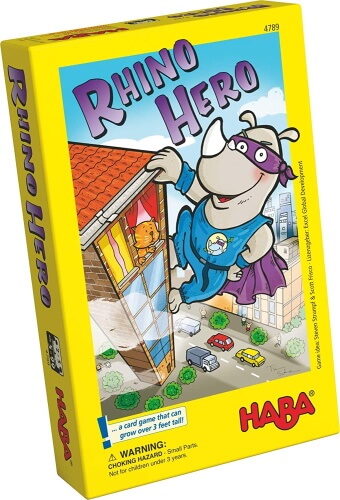
Rhino Hero at a Glance
| Game Type Animal Theme, Hand Management, Lose a Turn, Stacking and Balancing, | Play Time 5 - 15 mins | Skill/Complexity (1 - 5) Light |
| Age 5+ | Publisher(s) HABA | Published 2011 |
| Categories Family / Kids | Players 2- 5 (Ideal 3) | Cost $14.99 approx. |
| Our Rating 7.2/10 |
Rhino Hero might be the only game out there where physically bending the cards won’t give the game-collecting parents a heart attack. The game comes with a stack of bendable cards, and a stack of player cards. Players receive a hand of cards to start the game, and a starting card is placed on the table that contains a pattern. The starting player must fold cards and place them on the side to match the pattern on the card. Then, they place a card from their hand flat on top of the folded cards.
Rhino Hero might be the only game out there where physically bending the cards won’t give the game-collecting parents a heart attack.
Cards from players hand have both a special ability and a pattern that determines how the next player must fold and place cards to continue the tower. Cards might make players draw additional cards, reverse turn order, or place the Rhino Hero! When this happens, the next player must place the Rhino Hero on the marked spot before placing their folded cards, creating an additional dexterity challenge.
The game is over once a player has played their last roof card or when the building collapses. If the building collapses, the player with the fewest roof cards remaining wins the game.
Rhino Hero is an excellent, fun, and very portable game that comes in a very small box. This is definitely a game that can be enjoyed by both small kids and adults, and which adults might even continue to play after the kids have gone to bed!
5. Animal Upon Animal – Best Alternative to Jenga
It’s hard to think about family game night without thinking of Jenga, the classic tower stacking game where players take turns removing blocks from a tower and moving them to the top, trying not to be the player to make the tower fall. One of the downfalls of Jenga, however, is that it can be difficult for younger children to easily pull the blocks out of the tower without knocking everything over. Animal Upon Animal is a game that has big animal pieces that players try to stack, and are easy for small kids to enjoy because of how easy it is to handle the pieces.
It’s hard to think about family game night without thinking of Jenga, the classic tower stacking game where players take turns removing blocks from a tower and moving them to the top, trying not to be the player to make the tower fall.
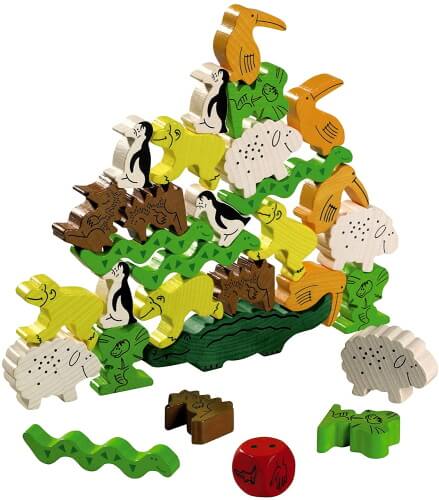
Animal Upon Animal at a Glance
| Game Type Animal Theme, Dice Rolling, Stacking and Balancing | Play Time 15 mins | Skill/Complexity (1 - 5) Light |
| Age 4+ | Publisher(s) HABA | Published 2005 |
| Categories Family / Kids | Players 2- 4 (Ideal 4) | Cost $24.99 approx. |
| Our Rating 7/10 |
In Animal Upon Animal, players try to be the first to get rid of all their animals (they start the game with 7). The game starts with a crocodile piece in the middle of the table, and on a player’s turn they roll a dice which determines what they have to do on their turn. They might have to stack 1 or 2 animal pieces on top of another animal on the table, or they might have to give an animal to another player who then has to place it.
What’s fun about Animal Upon Animal is the fact that the animals can be flipped upside down and placed in a number of ways, and it’s always exciting to see how the pile of animals can grow on the table. It’s just challenging enough for adults to stay engaged, while at the same time accessible enough for children of a younger audience to be able to be competitive. This is a solid pick for any family game collection!
6. Hammer Time – Reminiscent of an Arcade Coin Pusher
Many people will remember coin pusher games from arcades and amusement parks during their childhood – games where they put a coin into a shifting machine and try to get coins to get pushed off the edge. Hammer Time is a children’s board game that elicits a similar feeling of trying to get items to fall off the edge of a board, but the game does so in a way where players try to get pieces of a certain color to fall off, and not too many pieces total.
Hammer Time is a children’s board game that elicits a similar feeling of trying to get items to fall off the edge of a board……….
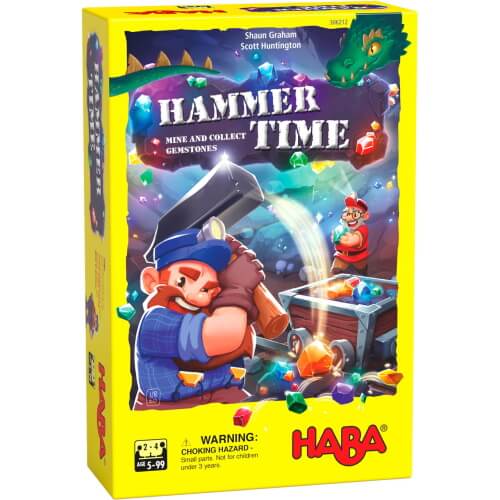
Hammer Time at a Glance
| Game Type Fantasy Theme, Action/Dexterity, Set Collection | Play Time 15 - 30 mins | Skill/Complexity (1 - 5) Light |
| Age 5+ | Publisher(s) HABA | Published 2020 |
| Categories Family / Kids | Players 2- 4 (Ideal 2) | Cost $24.99 approx. |
| Our Rating 7/10 |
The components of Hammer Time are made up of a game board (i.e., the game box), gems of different colors, wagon cards, task cards and, of course, a hammer. At the beginning of the game, each player receives 4 wagon cards and shuffles them, then flips over the top one face-up. Players try to fulfill 4 of their wagon cards, and the first player to do so wins the game. In case of a tie, the player with the most task cards fulfilled wins.
The gems are all dumped on top of the flipped-over box, and on a player’s turn, they take the hammer and tap the side of the box to try and get gems to fall off. If 8 or fewer gems fall off, the player can use gems to place on their wagon card to try and fulfill its goal. If a player knocks off more than 8 gems, then they don’t get to keep any.
Clear gems count as any color, and if a player fulfills the requirement of a task card (like even-numbered gems, etc.), they can take the card and it provides a clear-colored gem for a future turn. Once a player has completed a wagon card, they draw the next one from their stack of 4.
Hammer Time, like all other games on this list, is a very simple game but has the strong potential to appeal to younger children. The game feels kind of like a coin pusher game, except for the fact that you don’t want too many gems to fall off the side, but just enough and of the right colors to help you complete your goals. This game is a blast!
7. Ice Cool – Best Flicking Game
Part of a game’s ability to easily draw people in is its table presence, and few games have managed to make people curious when they see it set up on the table than Ice Cool, a flicking game that is great as the title. This game is all about trying to move your penguin around the halls of a school in order to collect the fish of your color – or capture other penguins if you are playing the role of the hall monitor.
This game is all about trying to move your penguin around the halls of a school in order to collect the fish of your color – or capture other penguins…….
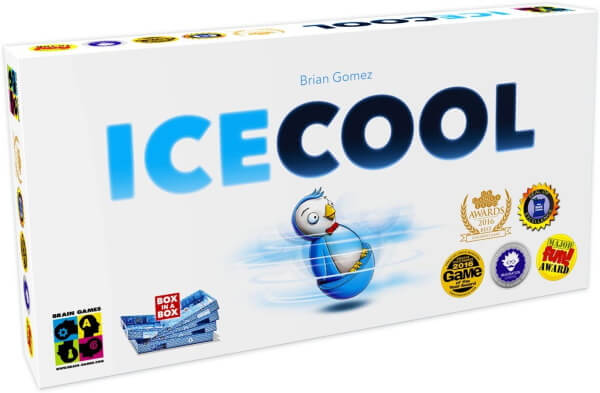
Ice Cool at a Glance
| Game Type Animal Theme, Action/Dexterity, Area Movement, Flicking, Take That | Play Time 30 mins | Skill/Complexity (1 - 5) Light |
| Age 6+ | Publisher(s) Brain Games and Others | Published 2016 |
| Categories Family / Kids | Players 3- 4 (Ideal 4) | Cost $24.99 approx. |
| Our Rating 7.2/10 |
The game box itself is comprised of several smaller crate-style boxes, which come together to form a school made up of halls and doors. Each player gets a penguin of a certain color, and the game is all about flicking the penguin around the school. The penguins are weighted at the bottom and wobble back and forth, so when you flick them, they spin this way and that. You can actually get pretty good at getting penguins to get them to do what you want – maneuvering through doors at a curve, flying over walls, or going in a straight line.
Each round, one player takes on the role of a hall monitor trying to catch class-skipping students, and the other players are students trying to grab the fish of their color and not getting caught by the hall monitor. On a player’s turn, they simply flick their penguin. If they are playing as a student and move through a door with a fish of their color on top of it, they collect the fish and one bonus card. The bonus cards are numbered 1-3 and are worth points at the end of the game, but can also be used for a bonus turn in the case that a player has two cards of the same value.
If a player is playing as the hall monitor, and they manage to flick their penguin into another player’s, that player has to go back to the start space and the hall monitor collects the other player’s hall pass. A round ends once all students have collected their fish or the hall monitor has caught all the students. At the end of the round, the player who played the hall monitor gets bonus cards equal to the number of hall passes they collected. Players who did not get caught also get to draw a bonus card.
The game ends once each player has had the chance to play the hall monitor once, and then players add up the value of their bonus cards. The player with the most points wins!
Ice Cool is another game that adults can easily enjoy, and one that younger children around the age of 5 will have no problem getting good at. The game has very simple rules, but you can actually practice at getting good at flicking the penguins around, and this seems like a game that families will be playing for many years to come.
8. Coconuts – Best Silly Fun
Sometimes it’s fun to have a game of pure silly chaos, with pieces flying everywhere and everyone having a great time around the table. If you’re looking for that kind of family gaming experience, you definitely can’t go wrong with Coconuts, a game where players launch coconuts from monkey launchers into cups in the center of the table. When you sink a coconut into a cup, you take the cup and try to be the first player to complete a pyramid on your player board.
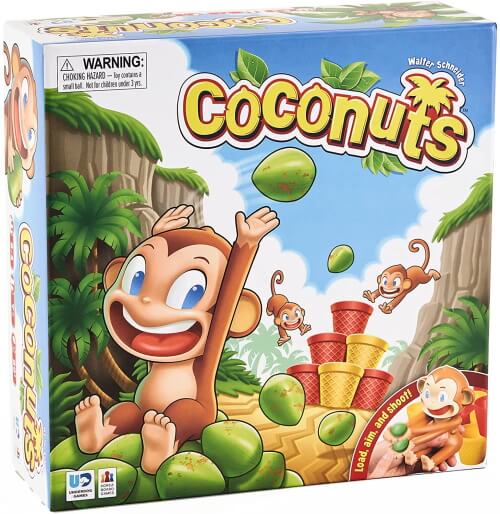
Coconuts at a Glance
| Game Type Animal Theme, Action/Dexterity, Push Your Luck, Take That | Play Time 20 mins | Skill/Complexity (1 - 5) Light |
| Age 6+ | Publisher(s) Underdog Game store and Others | Published 2013 |
| Categories Family / Kids | Players 2- 4 (Ideal 4) | Cost $30.99 approx. |
| Our Rating 8.2/10 |
The wonderful thing about Coconuts is that there are many different ways you can alter the game depending on the people you are playing with. For example, the game comes with a stack of player cards that players can use for special abilities on their turn. If you are playing with a young audience, you can simply remove those cards. Or, you can include them if you are playing with adults and are trying to mix things up! Technically, the game specifies that players take turns launching coconuts, but many people choose the play the game simultaneously, with players all launching coconuts at the same time and trying to build their pyramid.
The wonderful thing about Coconuts is that there are many different ways you can alter the game depending on the people you are playing with.
In any case, the game is very easy for young children to grasp and they tend to have a lot of fun with this game. It does a good job of teaching children basic physics and how far back they must pull back the monkey arms to launch the coconut just the right distance to make it into the cup they want. Be warned, however, that coconuts will end up all over the floor and you are bound to have some missing eventually. You can purchase the game at a very affordable price-point, which makes it less stressful to see game components on the floor.
9. Dragon’s Breath – Best Guessing Game
The Spiel des Jahres is the prestigious game of the year award in Germany, and many modern family classics have received this recognition, like Ticket to Ride, Carcassonne, and Dominion. Another award is handed out each year called the Kinderspiel des Jahres, or Children’s Game of the Year, which targets the younger audience. The next two games are both ones that have won this award and are excellent picks for streamlined board games that children enjoy.
The Spiel des Jahres is the prestigious game of the year award in Germany, and many modern family classics have received this recognition, like Ticket to Ride, Carcassonne, and Dominion
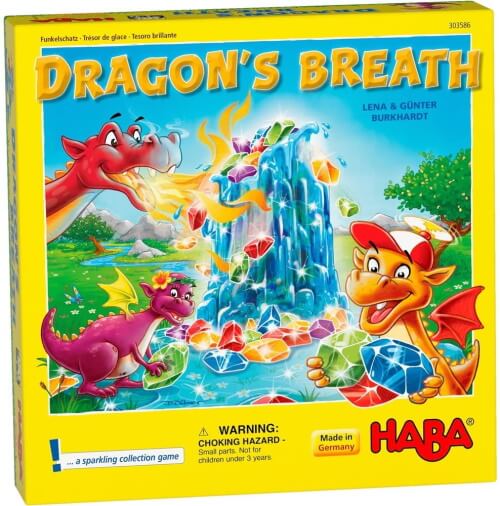
Dragon's Breath at a Glance
| Game Type Fantasy Theme, Action/Dexterity, Push Your Luck, Take That | Play Time 15 - 20 mins | Skill/Complexity (1 - 5) Light |
| Age 5+ | Publisher(s) HABA | Published 2017 |
| Categories Family / Kids | Players 2- 4 | Cost $21.99 approx. |
| Our Rating 8.3/10 |
Dragon’s Breath won the 2018 Kinderspiel des Jahres award, and is a game by Lena and Gunter Burkhardt. Gunter has designed some rather under-rated Euro board games like Ulm and Seeland, and it’s great to see him design titles for kids.
In Dragon’s Breath, players try to gain the most sparkling stones by the end of the game from a column of ice that will be slowly melted by…dragon breath. At the beginning of the game, a column of rings is filled with gems of different colors. Each round, players will select a color, and the top ring will be lifted off the column with gems spilling onto the board. Each player will collect the gems of the color they selected. The game ends once the last ice ring has been taken off the game board, and the player with the most sparking stones wins the game!
The great thing about Dragon’s Breath is the fact that kids can play as strategically as they’d like, but they can also play simply based on luck. If a player selects red, for instance, they might still get a bunch of red gems if they happen to fall out of the tower. Older kids might take a long hard look at the tower to see what color of gems they think will have the most fall out when the top ring is removed. In any case, the game has a beautiful table presence with gems of many different colors, and children get very excited when the gems pour out onto the board. With very easy-to-understand rules, it’s no wonder this game received the Kinderspiel des Jahres award!
10. Dragomimo – Best Domino-Style Game
Dragomimo, also a winner of the Kinderspiel des Jahres award in 2021, is based on the original Kingdomino game which won the 2017 Spiel des Jahres. While the original game isn’t incredibly complex or difficult for older kids to grasp, Dragomimo is really catered toward the 5+ audience (though the game could can easily play ages 4+ according to BoardGameGeek).
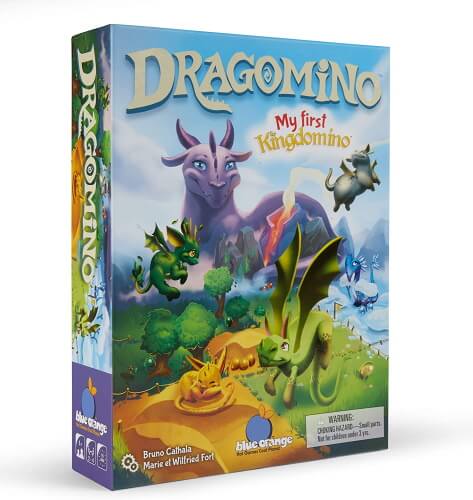
Dragomimo at a Glance
| Game Type Fantasy Theme, Pattern Building, | Play Time 15 mins | Skill/Complexity (1 - 5) Light |
| Age 5+ | Publisher(s) Blue Orange Games and Others | Published 2020 |
| Categories Family / Kids | Players 2- 4 | Cost $19.99 approx. |
| Our Rating 8.8/10 |
In Dragomimo, players try to gain the most points by discovering baby dragons. Throughout the course of the game, players will draft domino-shaped tiles from the middle of the table and place them in their “exploration zone,” or domino display. For every square of a terrain type touching a matching terrain type, a player will draw an egg token of that color and flip it over to reveal either a baby dragon or a mummy dragon. The mummy dragon isn’t worth points, but will allow the player to be starting player in the next turn.
In Dragonimo, players try to gain the most points by discovering baby dragons. Throughout the course of the game, players will draft domino-shaped tiles from the middle of the table and place them in their “exploration zone,” or domino display.
Dragomimo has just enough going on in it to make younger children have to think about which tiles they would like to take, and where they would like to place it to get the most dragon eggs. But it’s definitely not overwhelming, and does a great job at easing kids into the concept of tile-placement and matching terrain, mechanisms found in games like the original Kingdomino and Carcassonne.
11. Drop It! – Best Alternative to Plinko
One of the benefits of a game mentioned earlier in this list, Dragon Breath, is that kids can play as strategically as they are ready for but can still remain engaged even if they don’t necessarily know what is going on. Another game that fits this category quite well is Drop It!, a game that feels very similar to Plinko-style games where players drop a ball or other object into a vertical board full of pegs, and then wait in anticipation to see where it lands at the bottom.
……….Drop It!, a game that feels very similar to Plinko-style games where players drop a ball or other object into a vertical board full of pegs, and then wait in anticipation to see where it lands at the bottom.
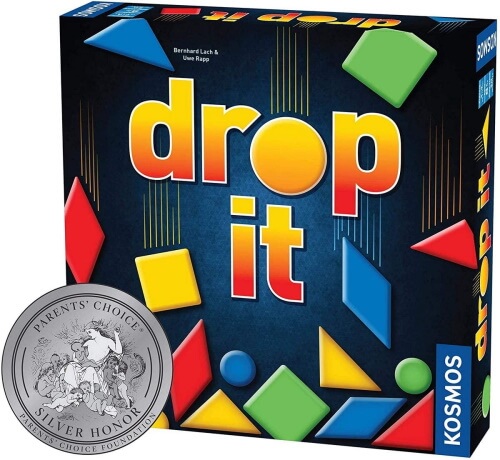
Drop It! at a Glance
| Game Type Action/Dexterity | Play Time 30 mins | Skill/Complexity (1.5 - 5) Light |
| Age 8+ | Publisher(s) KOSMOS | Published 2018 |
| Categories Family / Kids | Players 2- 4 | Cost $29.99 approx. |
| Our Rating 7.1/10 |
In Drop It!, each player gets a set of various shapes of a particular color, and they take turns dropping those shapes into a plastic case display. Players will get points based on where their shape lands – the higher up the tower, the more points they get. There are also bonus spots where players can gain additional points if their shape is touching it. However, players will lose all points if they are touching a piece of the same shape or color, or for touching a section of the bottom or sides that matches their color or shape.
Adults will have a lot of fun with this game, trying to line up their shapes just right to get a lot of points. But just when they think they have it all figured out, the pieces will all move around and send their shape to a spot where they will get no points. Younger children can really enjoy this game as well as they will likely find dropping shapes into the tower a lot of fun. It won’t take them long to understand how they can gain (or lose) points, and adults can help coach the kids on where they should try dropping their shapes.
The game ends once all players have dropped all of their shapes, and the player with the most points is the winner of the game. Drop It! is definitely a game that can be taught to anyone of any age including 5 year olds in a really short amount of time, even if it’s just as simple as, “Pick a shape and drop it into the tower.”
12. My First Stone Age – Best Resource-Management Game
Resource management is a common mechanism found in many modern board games, including the very popular light-weight worker-placement game Stone Age. For parents wanting to introduce their kid to the idea of collecting resources of different types in order to fulfill objectives, My First Stone Age is a game definitely worth checking out.
For parents wanting to introduce their kid to the idea of collecting resources of different types in order to fulfill objectives, My First Stone Age is a game definitely worth checking out.
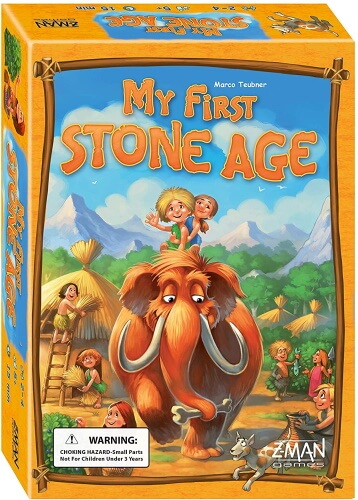
My First Stone Age at a Glance
| Game Type Prehistoric Theme, Memory, Set Collection | Play Time 15 mins | Skill/Complexity (1.2 - 5) Light |
| Age 5+ | Publisher(s) Z-Man Games | Published 2016 |
| Categories Family / Kids | Players 2- 4 | Cost $39.99 approx. |
| Our Rating 7.9/10 |
In My First Stone Age, players are attempting to be the first to build 3 huts. On a player’s turn, they flip over a forest token tile which will allow them to either move a certain number of spaces of move to a particular spot on the game board. Based on where a player lands, they will acquire a resource of a certain type. When a player lands on the trading post space, there are always 5 available resources, and players can trade resources from their supply with those available at the spot.
When players land on the hut spot, they can build one of the three available huts by discarding the resources listed. When players build a hut, they place it in one of the three available slots on their player shield, making it visually easy to see your progress. When players build a hut, the next hut in the pile is flipped over and made available to all players. The player who lands on the hut also flips all the forest token tiles face down, adding a memory component of the game as well since players can remember where tokens were in order to move a certain number of spaces or land on a particular space.
My First Stone Age is a very simple game that has streamlined mechanisms of collecting resources, trading resources, and fulfilling contracts. The components are big and colorful, and the game is very appealing and mentally-stimulating for kids around the age of 5.
– That’s about it for the best board games for 5 year olds category for now. Something new and great to play comes along, you’ll see it here.
